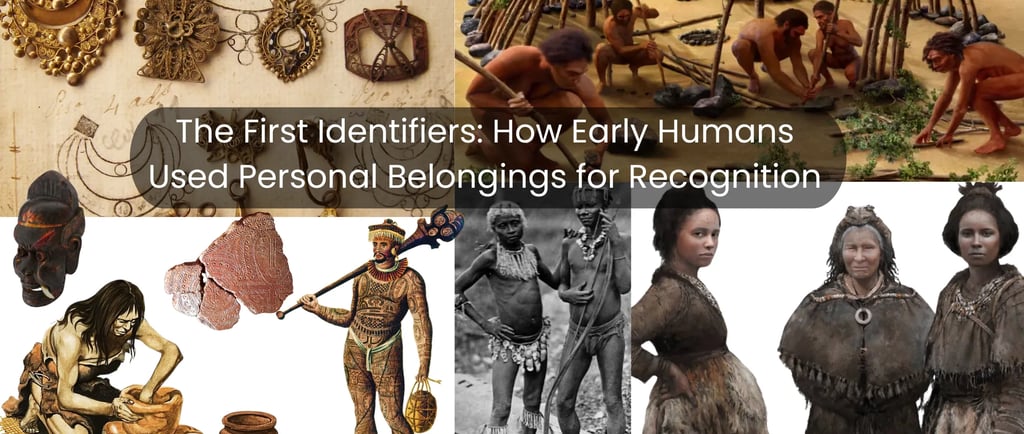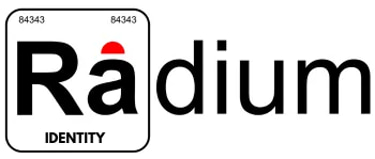The First Identifiers: How Early Humans Used Personal Belongings for Recognition
When we think about the ways in which humans recognize each other today by photographs, identity cards, personal usernames on the web, or even biometric information, such as fingerprints or retinal scans.
Shubhanshi
3/1/20256 min read


When we think about the ways in which humans recognize each other today by photographs, identity cards, personal usernames on the web, or even biometric information, such as fingerprints or retinal scans. However, the concept of identification is far from modern; in fact, it dates back to the earliest periods of human history. Long before the invention of writing or photography, early humans had their own ways of identifying and differentiating one another through the use of personal belongings. This blog describes the history and evolution of these early markers and their contribution to the computerized recognition systems we use today, culminating in a voyage across time, from the Paleolithic through the formation of more structured societies, exploring archaeological and anthropological sources that provide information about this long-standing practice.
The Need for Identification
Recognition has always been an important part of human life and culture. The belief of individuals in the social stability of the early human population was an important ability, providing convenience in trade, protection against violence and ensuring existence. Personal belongings often serve as markers of identity, indicating a person's social status, tribal connection and personal achievements. It was not only working, but it was also very meaningful and symbolic.
Identity is a notion that is profoundly linked to the recognition that one has a place and to assuming a place amongst others. For early humans, personal belongings provided a tangible means to express individuality and group membership in a world without formalized language. They served multiple purposes:
Functional Utility: Tools and objects were crafted to serve practical needs—hunting, gathering, and protection.
Social Signaling: However, with the passage of time, these objects became symbols that both conveyed status, membership in a group, and spiritual convictions.
Cultural Expression: Decoration, embellishment and style of these objects all bore the cultural stories and the values of early human groups.
In our modern age, where identity is often discussed in terms of digital footprints and social media profiles, it is both humbling and enlightening to revisit how our ancestors expressed who they were through the personal objects they cherished and displayed.
Ornamentation and Adornment
Ornamentation was one of the earlier techniques of identification from a personal point of view. Primitive man used to wear different objects, like beads, shells and feathers. It is archaeologically established that as recent as 100,000 years ago, an ancestral species of Homo sapiens produced and wore adornments. These tokens were not only decorative, but they were, in a way, very crucial identifiers. Construction and materials used for ornament can provide clues in the form of age group, gender or social status in society.
For example, in prehistoric Europe, the pregnant culture (which was about 30,000 years ago) is known for its complex gems and jewels. These items were usually carved with mammoth ivory, animal teeth and seashells. The particular patterns and materials applied were idiosyncratic within certain groups and locations and thus capable of identifying individuals within the community and their members different from outsiders.
Tattoos and Body Paint
Tattoo and body paint is a second form of body marking that is very old. Tattooing has been carried out for thousands of years and the oldest evidence has been discovered on the mummified human Ötzi the Iceman (living about 5,300 years ago). The body of Ötzi has multiple tattoos which are thought to have been beneficial both clinically and symbolically.
In many societies tattoos were used to mark a person's affiliation with a specific tribe or clan. They might also encode success in personal pursuits, for example, successful hunts or wars. Much like, body paint, tattoos were frequently used in ritualistic settings, and certain colours and patterns referred to the varying tasks and standing in society. The application of body paint and tattoos was a deeply personal process, usually involving ceremonies and rites of passage that reinforced the identity and place of the individual within the group.
Clothing and Personal Attire
Clothing as a device of personal identification, has a rich history. Primitive people designed garments from hides and plant fibers, and these garments were often decorated with pearls, quilting and similar techniques. The style and decoration of clothing varied widely between different cultures and regions, so that individuals could visually identify each other based on their outfits.
In certain cultures, however, specific clothes were assigned to special social classes, such as shamans, chieftains or warriors. These garments were often decorated with emblems with control and power, and served as unambiguous markers for the user's status and role. For example, among the Plains Indians in North America, elaborate feathered headgear was carried by fighters and leaders as a brand of their bravery and leadership.
Tools and Weapons
Personal belongings were not limited to adornments and clothing; tools and weapons also played a significant role in early human identification. Tools and weapons belonging to a person for his/her skilled craft were highly prized, and an individual's tool kit was often a reflection of skill and rank.
The high quality and workmanship of individuals' tools and weapons, in many hunter-gatherer societies could reflect an individual's skill in hunting, warfare, or toolcraft. Useful designs and patterns were often imprinted or engraved on such items so that they were unique and identifiable. For example, Inuit peoples in the Arctic developed beautifully carved bone and ivory tools and weapons, all of the work bearing the maker's skill and cultural lineage.
Pottery and Artifacts
Pottery and other artifacts were also used as markers in prehistoric human groups. The designs and motifs applied to clay utensils featured the country's distinctive cultures and regions. These decorative elements were more than just options for beauty; they expressed important information about the manufacturer's identity and community.
For example, early Japan's Jomon culture is dated between 14,000 years ago and 300 BC, which is famous for its evidence-rich pottery with indented cord-pattern designs. These patterns were specific to the Jomon people, and provided a type of cultural marker that separated them from other contemporary groups.
Personal Belongings as Heirlooms
Personal items frequently contained strong sentimental value and were inherited for many generations to be used as heirlooms. These items not only served as identifiers but also as links to ancestral heritage and history. Heirlooms contained narratives and family lore, sustaining the identity of the owners and their belonging to the family line.
Remains of some objects such as amulets, totems, or ritual objects were held to be sacred among many indigenous societies, and were passed down to family members. Such objects were thought to carry spiritual meaning and were used in ceremonies and rituals in an endeavor to establish and affirm the identity of the individual and their role within the community.
Symbols and Totems
Symbols and totems were strong means of identification in ancient human societies. Totemism, the view that humans are in a spiritual rapport with natural objects (e.g., animals or plants), is a widespread occurrence in a variety of indigenous societies. Totems were typically represented by physical embodiments; for example, carvings or paintings, and were used as clan or tribe markers.
For instance, totem poles, carved by the Native American peoples of the Pacific Northwest of North America, featured animal and mythical forms. The figures on the totem pole included each clan or family line and served as a visual expression of group identity and history. These totem poles were highly visible in communal areas thereby serving to reinforce the feeling of belonging and being a member of the tribe.
The Evolution of Personal Identification
The means of personal identity employed by ancient people have changed dramatically, but the principles of the obstacles have been the same. The use of individual goods to express identification, status and affiliation is a will for recognition and a human need for connection.
Along with the growing sophistication of societies, identity systems have also increased in complexity. The discovery of writing enabled the recording of names, genealogical records, and personal histories. The evolution of photography and identification documents in the nineteenth and twentieth centuries altered the mode by which we recognize and identify individuals. Today, biometric data and digital identities continue to push the boundaries of personal identification, building on the foundations laid by early ancestors.
Conclusion
The earliest identifiers devised by early humans were not mere functional objects; they were actually very symbolic and culturally relevant. From ornamentation and tattoos to clothing and tools, these personal belongings served as powerful markers of identity, allowing individuals to distinguish themselves and their communities. The long history of these initial identifiers emphasizes the continuing significance of recognition and implication in human society. As we move forward with innovative developments and new ways of identification, we have the opportunity to draw upon our ancient forebears not only for motivation but also for insights into the eternal human drive to be part of what is 'Ours'—an expression of self.
Solutions
Advanced identity verification and KYC services.
Quick Access
Access
© 2025. All rights reserved.
